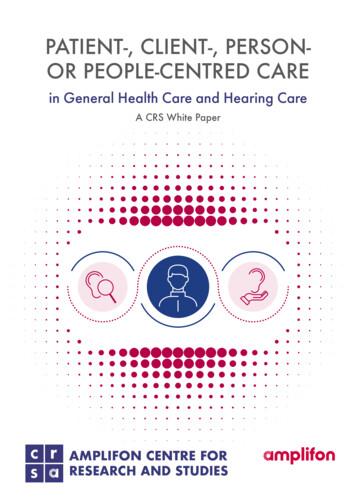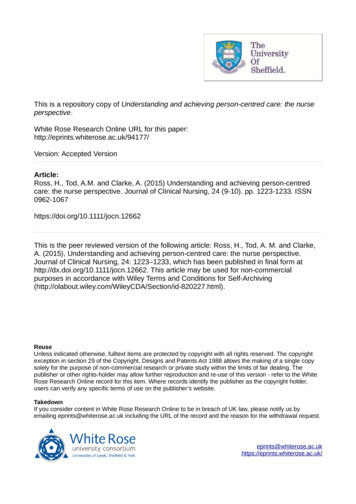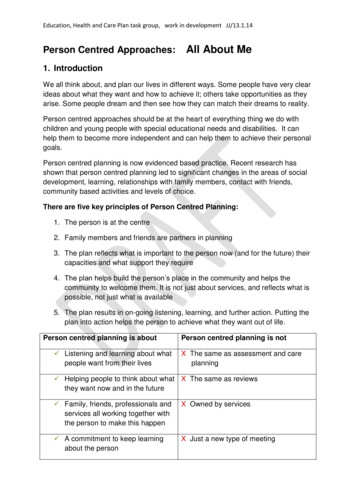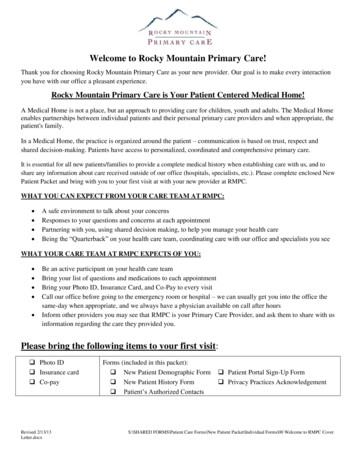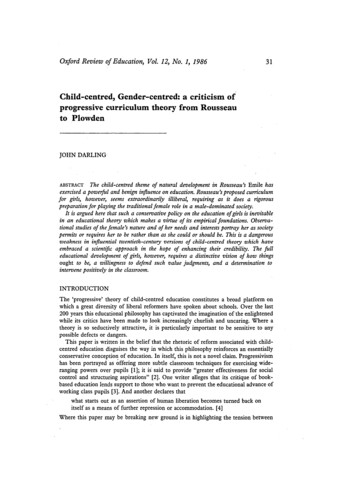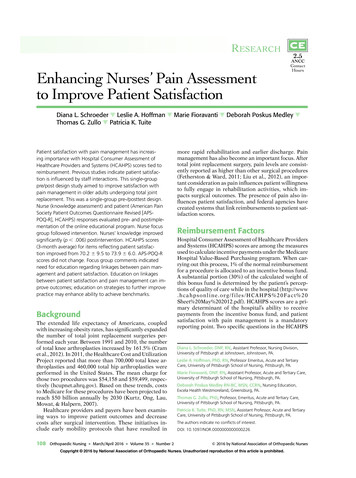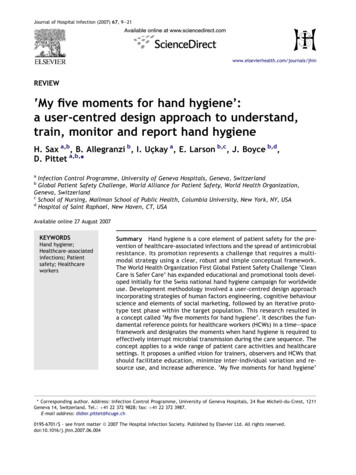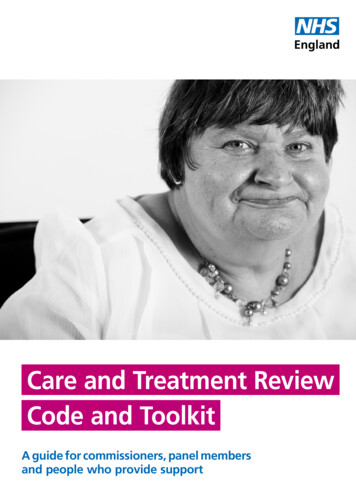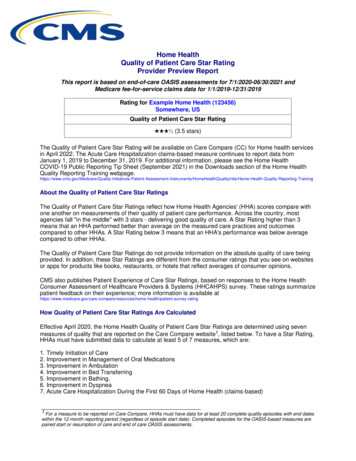
Transcription
PATIENT-CENTRED CARE:IMPROVING QUALITY AND SAFETYBY FOCUSING CARE ON PATIENTSAND CONSUMERSDiscussion paperDraft for public consultationSeptember 2010
This discussion paper is available on the website of the Australian Commission on Safety andQuality in Health Care (ACSQHC), www.safetyandquality.gov.auThe ACSQHC will be accepting written submissions up to 17 December 2010. Submissionsmarked ‘Patient- and Consumer-Centred Care’ should be forwarded to:GPO Box 5480Or emailed to:SYDNEY NSW 2001mail@safetyandquality.gov.auPlease be aware that in order to ensure transparency and promote a robust discussion, allsubmissions will be published on the ACSQHC website, including the names of individuals ororganisations making the submission. The ACSQHC will consider requests to withhold thecontents of any submissions made in whole or part.AcknowledgmentsThis discussion paper is based on preliminary work undertaken on consumer engagementfunded by the Australian Commission on Safety and Quality in Health Care (ACSQHC) andshould be considered in the context of the ACSQHC’s development of a National Safety andQuality Framework and the National Safety and Quality Healthcare Service Standards.The ACSQHC wishes to acknowledge the contributing authors and staff for their work on thisguide, including:Dr Karen LuxfordDr Donella PiperDr Nicola DunbarMs Naomi PooleThe ACSQHC gratefully acknowledges the kind permission of Dr Karen Luxford to reproduceher checklist in this document.Editing by Biotext, Canberra.
ContentsContentsContents .1Acronyms and abbreviations.5Executive summary . 7Introduction .1112What is patient-centred care? . 131.1Concepts of patient-centred care . 131.2Some definitions of associated terms. 15Consumer-centred care . 15Person-centred care . 15Personalised care . 151.3The evidence for patient-centred care. 151.4Patient-centred care as a dimension of high-quality health care. 17International approaches and initiatives. 212.1Policy-level drivers for patient-centred care . 21Collecting and publishing patient experience data . 21Performance reporting and choice of providers. 22Financial incentives . 232.2Emerging views on the appropriate outcomes of services . 24Creating public value . 25Valuing the experience . 25Driving efficiency gains . 252.3Approaches and strategies to promote patient-centred care. 26‘Best buys’ for improving patient experience . 26Consultation styles and communication training. 26Patient feedback reporting. 27Patient and carer engagement in personal care. 27Patient and carer access to information and education. 28Implementing rights-based patient constitutions, charters or codes. 28User-centred design and redesign. 29Experience-based co-design . 29Patient and carer engagement at the governance level . 30Leadership and change management strategies. 30Staff and practice development . 31Values training . 31Staff satisfaction strategies. 31Accountability strategies . 31Improved complaints processes . 32Patient-Centred Care: Improving Quality and Safety by Focusing Careon Patients and Consumers — Discussion Paper1
Contents3452.4Case study: Medical College of Georgia Health Inc, Georgia, US . 322.5An overview of leading organisations . 33World Health Organization. 33Picker Institute . 33Institute for Patient- and Family-Centered Care . 34Studer Group . 34Planetree . 35Institute for Healthcare Improvement. 35Kenneth B Schwartz Center . 36The King’s Fund. 36The relevance of patient-centred care to the Australian health system . 373.1The relevance of patient-centred care to a mixed healthcare system . 373.2National health reform . 383.3National strategies and initiatives promoting patient-centred care . 39Australian Charter of Healthcare Rights . 39National Safety and Quality Framework . 39National Primary Health Care Strategy. 40National Chronic Disease Strategy and National Service ImprovementFrameworks . 41National Mental Health Plan . 41Community Pharmacy Agreement. 41Aboriginal and Torres Strait Islander primary healthcare policy . 41Current jurisdictional and other activity in Australia. 434.1Listening to patient feedback. 434.2The Australian Institute for Patient- and Family-Centred Care. 444.3Examples of state and territory initiatives . 44ACT Health . 45NSW Health . 45Queensland Health . 46Victorian Department of Health. 47WA Health. 484.4Case study 1: Australian Capital Territory — Calvary Health Care Simply BetterProgram. 494.5Case study 2: South Australia — Flinders Medical Centre EmergencyDepartment Redesign project. 50Making progress on patient-centred care in Australia . 515.1Refocusing the way we look at quality in health care . 515.2Performance monitoring — towards standardised measurement . 525.3Organisational strategies. 53Data driving change: using regular collection and feedback of patient careexperience . 542Patient-Centred Care: Improving Quality and Safety by Focusing Careon Patients and Consumers — Discussion Paper
ContentsThe importance of committed senior leadership. 55Engaging patients, families and carers as partners. 55Resourcing improvement of care delivery and environment. 56Building staff capacity and a supportive work environment . 57Accountability at all levels for improving patient-centred care . 59An organisational culture that strongly supports learning andimprovement . 606Next steps . 61Your views. 62Appendix A Assessing organisational readiness to implement patient-centred care . 63Tool 1: Patient-centred care organisational status checklist . 64Tool 2: Where do we stand?. 65Appendix B Supportive resources. 69References .75Patient-Centred Care: Improving Quality and Safety by Focusing Careon Patients and Consumers — Discussion Paper3
Acronyms and abbreviationsAcronyms and abbreviationsABSAustralian Bureau of StatisticsACSQHCAustralian Commission on Safety and Quality in Health CareAHRQAgency for Healthcare Research and QualityCAHPSConsumer Assessment of Healthcare Providers and SystemsCMSCenters for Medicare and Medicaid Services (United States)CQUINCommissioning for Quality and Innovation payment frameworkEBDexperience-based designGPgeneral practitionerH-CAHPSHospital Consumer Assessment of Healthcare Providers and SystemsIHIInstitute for Healthcare ImprovementIOMInstitute of Medicine (United States)IPFCCInstitute for Patient- and Family-Centered Care (United States)MCGMedical College of GeorgiaNHSNational Health Service (United Kingdom)OECDOrganisation for Economic Co-operation and DevelopmentP4Ppay for performanceWHOWorld Health OrganizationPatient-Centred Care: Improving Quality and Safety by Focusing Careon Patients and Consumers — Discussion Paper5
Executive summaryExecutive summaryPatient-centred care is health care that is respectful of, and responsive to, the preferences,needs and values of patients and consumers. The widely accepted dimensions of patientcentred care are respect, emotional support, physical comfort, information and communication,continuity and transition, care coordination, involvement of family and carers, and access tocare. Surveys measuring patients’ experience of health care are typically based on thesedomains.Research demonstrates that patient-centred care improves patient care experience and createspublic value for services. When healthcare administrators, providers, patients and families workin partnership, the quality and safety of health care rise, costs decrease, and providersatisfaction increases and patient care experience improves. Patient-centred care can alsopositively affect business metrics such as finances, quality, safety, satisfaction and marketshare.Patient-centred care is recognised as a dimension of high-quality health care in its own right andis identified in the seminal Institute of Medicine report, Crossing the Quality Chasm,1 as one ofthe six quality aims for improving care. In recent years, strategies used in the US and UK toimprove overall healthcare quality, such as public reporting and financial incentives, haveemerged as policy-level drivers for improving patient-centred care.In Australia, a patient-centred approach is supported by the Australian Charter of HealthcareRights, the National Safety and Quality Framework, other national service standards, reports ofstate-based inquiries, and a range of jurisdictional and private sector initiatives.Recent national health reform arrangements (such as the Performance and AccountabilityFramework of the 2010 National Health and Hospitals Network Agreement) provide furtherincentives to improve patient-centred care by linking it to performance and funding. Anotherdriver for improving patient-centred care is the establishment of a National PerformanceAuthority to report transparently on a range of performance indicators, including ‘patientsatisfaction’ for every Local Hospital Network, public hospital, private hospital and primaryhealthcare organisation.Against this background, Australian healthcare organisations are becoming increasinglyinterested in patient-centred care. Most organisations can readily put patient charters andinformed consent policies in place, but many find it hard to actively change the way care isdelivered, and struggle to involve patients and learn from their experience.2 Key strategies fromleading patient-centred care organisations include demonstrating committed senior leadership;regular monitoring and reporting of patient feedback data; engaging patients, families andcarers as partners; resourcing improvements in care delivery and environment; building staffcapacity and a supportive work environment; establishing performance accountability; andsupporting a learning organisation culture.Internationally, healthcare services use a range of strategies to promote patient-centred care,including staff development, leadership, collecting and reporting patient feedback, redesigningand co-designing service delivery, implementing patient rights charters, and engaging patientsand carers as partners in improving care. A range of international organisations provideframeworks and tools to help organisations implement these strategies, such as the US-basedInstitute for Patient- and Family-Centered Care, and Planetree.Patient-Centred Care: Improving Quality and Safety by Focusing Careon Patients and Consumers — Discussion Paper7
Executive summaryBased on these strategies and frameworks (and taking into account Australia’s healthcaresystem, with its mix of public and private sectors), practical policy and service-levelrecommendations to foster patient-centred care are outlined in this discussion paper.Summary of recommendationsPolicy levelRecommendation 1Policy makers and regulators should include patient-centred careas a dimension of quality in its own right in strategic and otherpolicy documentation.Recommendation 2Patient survey tools should include a core set of itemsstandardised at a national level to enable the collation andcomparison of patient care experience data in key healthcaresettings.Recommendation 3Patient surveys used to assess patient care experience need toinclude questions specifically addressing recognised patientcentred care domains and assess more than patient ‘satisfaction’.Recommendation 4Implementation of healthcare funding models incorporatingperformance-based payments should include ‘improving patientcare experience’ as an integral indicator of health service qualityimprovement.Recommendation 5To improve transparency, Australian policy makers and regulatorsshould make data regarding patient care experience in healthservices publicly available via websites.8Patient-Centred Care: Improving Quality and Safety by Focusing Careon Patients and Consumers — Discussion Paper
Executive summaryOrganisational levelHealthcare service executives and managers should:Recommendation 6Ensure that systems are in place for the regular collection andreporting of patient care experience data through quantitativepatient surveys and qualitative, narrative-based sources.Recommendation 7Ensure that organisational approaches to quality improvementinclude feedback about patient care experience — alongsideclinical and operational data — when determining health serviceaction plans.Recommendation 8Contribute to the evidence base for patient-centred care byrecording and publishing changes in key organisational andpatient outcome metrics over time.Recommendation 9Develop a shared patient-centred mission that senior leaderscontinually articulate to staff to promote the implementation ofpatient-centred care.Recommendation 10Develop and implement policies and procedures for involvingpatients, families and carers in their own care and, at a servicelevel, in policy and program development, quality improvement,patient safety initiatives and healthcare design.Recommendation 11Ensure that the service meets the ACSQHC National Safety andQuality Healthcare Service Standard for ‘Partnering withConsumers’.Recommendation 12Resource patient-centred changes to care delivery based onpatient feedback and consumer input.Recommendation 13Implement training strategies tailored to building the capacity of allstaff to support patient-centred care.Recommendation 14Focus on work environment, work culture and satisfaction of staffas an integral strategy for improving patient-centred care.Workforce surveys and review of staff recruitment and retentionrates should be undertaken at regular intervals to monitor workenvironment.Recommendation 15Integrate accountability for the care experience of patients intostaff performance review processes.Recommendation 16Foster a culture of learning within the organisation, equallylearning from successes and failures, including tragic events, topromote patient-centred care.Patient-Centred Care: Improving Quality and Safety by Focusing Careon Patients and Consumers — Discussion Paper9
IntroductionIntroductionThe health and health experiences of Australians compare well with those of other countries.Australia’s life expectancy at birth remains among the highest in the world. Death rates arefalling for many of our major health problems such as cancer, cardiovascular disease, chronicobstructive pulmonary disease, asthma and injuries, and survival from these conditionscontinues to improve.3In a recent Commonwealth Fund comparison4 of seven international health systems, Australiaranked highly demonstrating health care professionals’ commitment to high quality care.However, this achievement should be tempered with the awareness that there is still work to bedone. In 2008-09 a large proportion of the complaints made to Australian healthcarecommissioners were about health care professionals’ attitude and manner.5 It has beensuggested that these types of complaints may represent a failure to appreciate that in somecircumstances the emotional need of the patient may be as important as their physical state.6 Ifhealth care is to become truly responsive to the needs and desires of the patient then it will benecessary to refine the skills and capacity of health professionals as evidence for, and ourunderstanding of, how to implement patient-centred care becomes clearer.In 2009, the Australian Commission on Safety and Quality in Health Care (ACSQHC) released aproposed National Safety and Quality Framework7 that identified ‘patient-focused care’ as thefirst of three dimensions required for a safe and high-quality health system in Australia.Including this dimension in the framework reflected a growing recognition of the importance ofplacing the patient at the centre of the healthcare system. When the ACSQHC talked topatients, carers, consumers, clinicians, managers and policy makers about the proposedframework, there was strong support for the inclusion of this dimension and an overallframework that will set the strategic direction for safety and quality in Australia over the nextdecade.The proposed National Safety and Quality Framework contains a number of strategies forproviding care that is respectful of, and responsive to, the preferences, needs and values ofpatients and consumers. The ACSQHC is currently developing a series of guides that willsupport use of the framework in practice.In Australia there is wide and strong commitment to a healthcare system that focuses on theneeds of patients and consumers. Many health services and health-service providers havetaken steps to embed patient-centred care principles into practice, and provide care thataddresses for the needs and desires of the patient, as well as their immediate treatmentrequirements. However, for a range of reasons others can struggle to carry out patient-centredcare in practice and more specific and focused guidance in this area may be useful.Internationally, there has been a focus on patient-centred care for some time, particularly in theUS and UK. However, the health systems in these countries are different from the Australiansystem and questions arise as to whether the lessons and approaches that are usedinternationally can be applied here.To address these needs, the ACSQHC has prepared this discussion paper as the firstcomprehensive review of patient-centred care for Australia. The purpose of the paper is toinform practitioners, managers and policy makers who want to re-orient their systems andpractices to be more patient centred, and to work more closely with patients, consumers andcarers. The paper recommends strategies for how to do this, and provides backgroundinformation and helpful resources.Patient-Centred Care: Improving Quality and Safety by Focusing Careon Patients and Consumers — Discussion Paper11
IntroductionThe paper provides an in-depth discussion of the concepts and evidence regarding patientcentred care; a comprehensive review of international approaches and activities; and anexamination of some of the national, jurisdictional and other policies and activities in Australia tosupport patient-centred care. It focuses on strategies that healthcare organisations can use tosupport patient-centred care.This is the consultation edition of this discussion paper. The ACSQHC wants to know how theapproaches discussed in this paper may apply in Australia, whether the recommendations areuseful, and how to move forward in supporting patient-centred care. Details about how to makea submission to this consultation process are provided in Section 6.Within this paper, the term ‘patient-centred care’ is used, as this is the most commonly usedterm in research and literature in this area. The proposed National Safety and QualityFramework used the term ‘patient-focused care’ when it was released in 2009 and currentlyuses ‘consumer-centred care’. All these terms are conceptually similar, and emphasise thecentral roles of the patient, family, carer and consumer in individual aspects of care, and also inthe broader approach to improving health service planning and delivery.Much of the evidence and many of the examples provided in the discussion paper come fromtertiary healthcare settings, as this has been the main focus and application of patient-centredcare at a service level. However, many of the lessons and all the recommendations are equallyapplicable across the range of healthcare settings.Section 1 of this discussion paper defines the concepts and origins of patient-centred care.Section 2 examines international approaches and initiatives to patient-centred care, and Section3 examines its relevance to the Australian healthcare system. Section 4 highlights currentpatient-centred activity in Australia. In light of the international and current Australianapproaches, Section 5 discusses the way forward for patient-centred care in Australia, andprovides recommendations. Section 6 sets out the consultation process. The appendicesinclude checklists to help organisations assess their readiness for improving patient careexperience, and a list of patient-centred care resources.12Patient-Centred Care: Improving Quality and Safety by Focusing Careon Patients and Consumers — Discussion Paper
1What is patient-centred care?1What is patient-centred care?This section provides an overview of the concept of patient-centred care as a dimension of highquality health care, including commonly used terms and their definitions, and a summary of theevidence base for this approach.Patient-centred care is:‘is an innovative approach to the planning, delivery, and evaluation of health care that isgrounded in mutually beneficial partnerships among health care providers, patients, andfamilies. Patient- and family-centered care applies to patients of all ages, and it may bepracticed in any health care setting.’81.1Concepts of patient-centred careThere are numerous proposed definitions of patient-centred care that encompass many of thesame core concepts, but there is no globally accepted definition.9 Modern concepts of patientcentred care are based largely on research conducted in 1993 by the Picker Institute, inconjunction with the Harvard School of Medicine. This research identified eight dimensions ofpatient-centred care that were originally documented in the book, Through the Patient’s Eyes:Understanding and Promoting Patient-Centered Care.10 These dimensions are: respect for patients’ preferences and values emotional support physical comfort information, communication and education continuity and transition coordination of care the involvement of family and friends access to care.This framework clearly defined the patient’s perspective for the first time and served as thefoundation for the NRC Picker surveys measuring patient experience of health care.11Patient-centred care also has a focus on staff. To succeed, a patient-centred approach shouldalso address the staff experience, because the staff’s ability and inclination to care effectivelyfor patients is compromised if they do not feel cared for themselves.12Organisation-specific concepts of ‘patient-centred care’ have also emerged. Some organisationsidentify individual elements of patient-centred care as part of an overall patient-centred careframework. An overview of leading organisations promoting strategies for patient-centred care ispresented in Section 2.The World Health Organization (WHO) uses the term ‘responsiveness’ in preference to ‘patientcentred care’. Responsiveness describes how a healthcare system meets people’s expectationsregarding respect for people and their wishes, communication between health workers andPatient-Centred Care: Improving Quality and Safety by Focusing Careon Patients and Consumers — Discussion Paper13
1What is patient-centred care?patients, and waiting times.13 WHO states that recognising responsiveness as an intrinsic goalof health systems reinforces the fact that health systems are there to serve people.Several studies reviewing patient-centred care in the US14 (cited in Goodrich and Cornwell200815) have identified the core elements in these frameworks as: education and shared knowledge involvement of family and friends collaboration and team management sensitivity to nonmedical and spiritual dimensions of care respect for patient needs and preferences the free flow and accessibility of information.In reviewing definitions of patient-centred care more generally, Cronin16 (cited in InternationalAlliance of Patients’ Organizations 20079) identified the same core elements.Similarly, Robb and Seddon17 identified the following common concepts in definitions of patientcentred care: informing and involving patients eliciting and respecting patient preferences engaging patients in the care process treating patients with dignity designing care processes to suit patient needs, not providers ready access to health information continuity of care.According to the International Alliance of Patients’ Organizations, the most common element indefinitions of patient-centred care is respect for the needs, wants, preferences and values ofpatients.9 While some definitions acknowledge patients’ rights and responsibilities (such as theNew Zealand Ministry for Health’s definition referred to later in this section), most do not, andsafety is rarely included in these definitions or frameworks.9In 2000, a five-day seminar was held in Salzburg, Austria, where 64 people from 29 countriesexamined what health care could become in a utopian land called PeoplePower. Theyenvisaged informed and shared decision making, mutual commitments to quality and healthoutcomes, and patient partnership in governance.18 The phrase ‘nothing about me without me’was their guiding principle; this phrase has since been popularised by authors and regulatorsand is considered synonymous with efforts to advance a vision for patient-centred care.1914Patient-Centred Care: Improving Quality and Safety by Focusing Careon Patients and Consumers — Discussion Paper
11.2What is patient-centred
Acronyms and abbreviations Patient-Centred Care: Improving Quality and Safety by Focusing Care on Patients and Consumers — Discussion Paper
